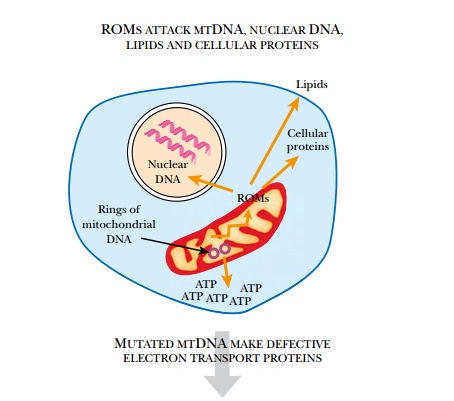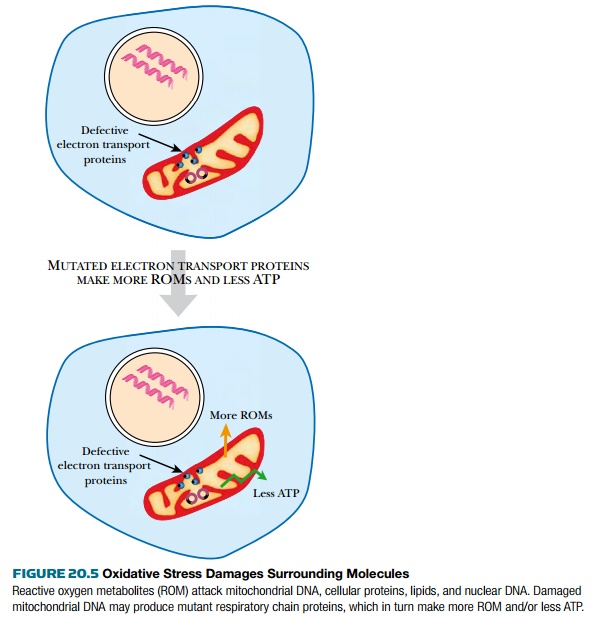Chapter: Biotechnology Applying the Genetic Revolution: Aging and Apoptosis
Mitochondria and Aging
MITOCHONDRIA
AND AGING
As described earlier, cellular
senescence and aging can be attributed to oxidative stress. Indeed, many people
consider oxidative damage the main culprit in aging. Because the majority of
oxidizing radicals are formed by aerobic respiration, the mitochondria play a central
role here. In brief, mitochondrial electron transport, which manufactures most
of the ATP, uses about 85% of the oxygen. Partial reduction of the O 2 molecule
creates highly reactive species including superoxide ions ( ŌĆó O 2 ŌłÆ ),
peroxides (H 2 O 2 ), and hydroxyl radicals (OHŌĆó). These reactive oxygen
metabolites damage protein, lipid, and DNA nonspecifically ( Fig. 20.5 ).


Mitochondrial DNA (mtDNA) is a main
target for ROM because it is not protected by histones and is close to the
electron transport chain. If the mtDNA is oxidized, mutations may accumulate in
the genes for energy production that are carried on the mtDNA. This may give rise
to a defective electron transport chain. Hence the mitochondria produce less
energy and cellular processes slow down. Moreover, defective electron transport
proteins may produce even more ROM, which damages the mtDNA further, so starting
a vicious cycle. Remember that each mitochondrion has multiple copies of its
genome, each cell has many mitochondria, and each tissue has many cells. Damage
from many events must accumulate for its effects to be noticeable. Cells that
are highly metabolically active tend to accumulate oxidative damage faster.
Antioxidant enzymes can alleviate the
effects of oxidant stress. There are several of these with varied roles. The
two most familiar are superoxide dismutase (SOD) and catalase .
There are two forms of SOD with different
metal ions at the active site. Cu/Zn SOD is found primarily in the cytoplasm,
whereas Mn SOD is found in the mitochondria. SOD converts superoxide ions to
oxygen plus hydrogen peroxide. Catalase converts hydrogen peroxide to oxygen
plus water. Superoxide dismutase :
2 ŌĆó O2 + 2 H + ŌåÆ O2 + H2 O2
Catalase : 2H2 O2 ŌåÆ O 2 + 2 H2O
If the microscopic transparent worm Caenorhabditis
elegans is treated with antioxidants, its mean life span increases
significantlyŌĆöby as much as 54%. These worms did not have a smaller body size
or reduced fertility, suggesting there was little nonspecific reduction in
metabolism. Other studies with the fruit fly, Drosophila melanogaster ,
support this view. Adding antioxidants to the diet of Drosophila has
varied effects on the average life span. For example, vitamin E
(alphatocopherol, a free radical scavenger) increased the life span by 13%, but
vitamin C had no effect. Three studies have shown that the antioxidant
thioproline increases life span, but the effect was highly variable (6% to 30%
increase). Genetically engineered flies with one extra gene for SOD or catalase
gene showed no change in life span. However, flies with three copies of SOD and
three copies of catalase gained a one-third increase in life span due,
presumably, to less oxidative damage.
Because metabolism and oxidation are
linked to aging, if the metabolic rate decreases, less damage should
accumulate, and the organism should live longer. Decreasing the body temperature
lowers the metabolic rate, as seen in cold-blooded or hibernating animals. Such
animals are able to survive on their body fat for extended periods of time by
lowering the heart rate and slowing metabolism. Decreased physical activity
also lowers the metabolic rate, as does limiting the diet. To test this theory,
mice were put on a calorie-restricted diet. This decreased blood glucose and
insulin levels. The mice also had improved insulin sensitivity and lower body
temperature. In support of the theory that calorie restriction limits oxidative
damage, the rodents had fewer reactive oxygen metabolites in the mitochondria
and accumulated less oxidative damage over their life span. The greatest effect
was seen in the brain and skeletal muscle, both tissues with high metabolic
rates.
Although these results are promising,
the jury is still out on whether antioxidants can lengthen the life span of all
organisms. Many factors can contribute to the oxidation ofproteins or DNA and
subsequent aging of the organism. Further research must be done to determine
the exact role each factor plays.
Related Topics